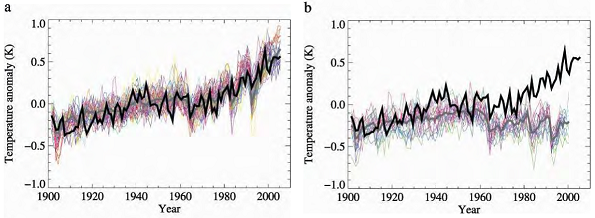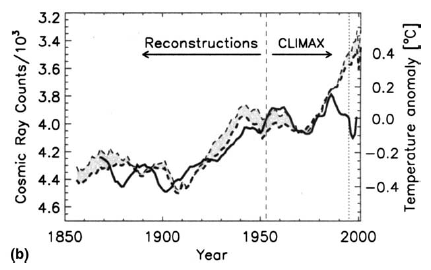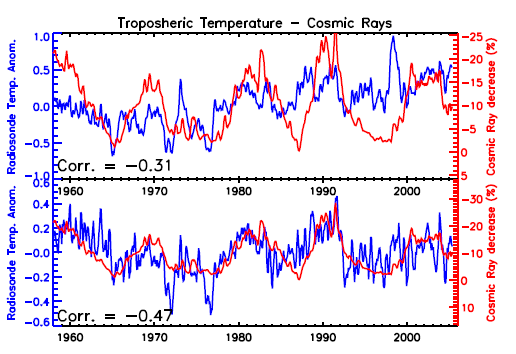Thursday, April 07, 2011
Solar warming and ocean equilibrium, Part 3: Solanki and Schuessler respond

Solar physicist Sami Solanki and his colleagues at Germany's Max Planck Institute for Solar System Research helped pioneer the use of cosmogenic isotopes from ice cores to create a proxy record for solar activity going back hundreds and thousands of years. Together with a group led by Ilya Usoskin at University of Oulu in Finland, Solanki describes "grand maximum" levels of solar activity from 1920 to 2000, with the sun being especially active since the 1940's.
Comparing this solar record to temperature, these scientists find a strong correlation between solar activity and temperature persisting until quite recently. For example, over the period of the instrumental temperature record, a 2004 paper by Solanki and Krivova finds that the correlation is quite close, "however":
However, it is also clear that since about 1980, while the total solar radiation, its ultraviolet component, and the cosmic ray intensity all exhibit the 11-year solar periodicity, there has otherwise been no significant increase in their values. In contrast, the Earth has warmed up considerably within this time period. This means that the Sun is not the cause of the present global warming.But does this conclusion follow? Their own evidence says that until 1980 the dominant driver of climate was solar activity (and their longer-term temperature-proxy comparisons say the same thing). So how can they assert that two decades of the highest solar activity on record can't be the cause of concurrent warming?
[Update/correction: the above quote is not directly from the 2004 paper by Solanki and Krivova but is from the Max Planck Institute's press release about the paper (likely written by Solanki himself).]
I suggested to Solanki and his colleagues that they must be implicitly assuming that by 1980 ocean temperatures had already equilibrated to whatever forcing effect the high level of solar activity was having. Otherwise warming would continue until equilibrium had been reached. Yet equilibration is never mentioned in any of their analyses.
Many thanks to Sami Solani and Manfred Schuessler for their important reply, finally making the implicit explicit. Here is the main part of their answer:
Dear Mr. Rawls,To clarify, I did not quite suggest that post-1970 warming might be due to the influence of the oceans. I suggested that it could be due to the sun. The hypothesis isn't that the oceans were giving up stored heat content but that they were continuing to absorb solar-driven heat. (Under the GCR-cloud theory, high solar wind blows the clouds away, increasing the amount of solar shortwave that pours into the oceans.)
You have raised an interesting question. Correlations between solar activity indices and climate assume that there is a constant lag between solar and climate variability (this is implicit in the nature of correlations). In some cases authors even implicitely or explicitely assume that this lag is zero, i.e. that the relationship is instantaneous. If we consider the period of time up to ca. 1970, then this lag lies roughly between 0 and 12 years (e.g., Solanki and Krivova 2003). Newer reconstructions, such as that of Krivova et al. (2007) tend to favour the lower lag. If we consider the period since 1970 alone, then the solar irradiance hasn't shown an increasing trend, but rather a decreasing one, in contrast to global temperature, which has increased substantially. If this increase is due to the hypothetical influence of the oceans, as you suggest, then of course these short lag times would not be realistic. This, however, would mean that the relatively good correlation between solar and climate variability prior to 1970 would also have to be discarded as due to chance and would cease to be of relevance. Lags cannot be changed at will, certainly not without a good physical reason, i.e. one based on computations, that at least approximately model the Earth system's behaviour.
Since Solanki and Schuessler see this slow-ocean-equilibration story as incompatible with short correlation lags, they are clearly identifying short lags with rapid equilibration. The question is whether this identification makes sense. If the equilibration process is not rapid, does it really mean that the short correlation lag between solar activity and temperature that these folks discovered must be mere chance? A simple counter-example shows the answer to be no.
Day vs. season
If you map the diurnal correlation between the strength of the sun's rays on your back porch and temperature in the shade, you will find that the maximum correlation occurs with only a few hour lag. At noon, sun strength is no longer increasing, while the rate of temperature increase is near its maximum, with temperatures continuing to rise until sometime mid-afternoon.
So you find this very strong and rapid correlation between sunlight and backyard temperature. You've been plotting it for a few months, and now it's June. There is no significant change day by day in the strength of the sun's rays, or their duration, yet somehow peak backyard temperatures keep going up. The end of June is hotter than the beginning of June. Do you say that this can't be explained by the sun because solar forcing has not been rising and you know that the temperature response to the sun is only a few hours?
This is exactly what Solanki et al. are doing. Instead of day vs. season they are finding temperature signals within the solar cycle and from one solar cycle to the next and assuming that these same response times apply to longer term changes in solar activity. But climate systems don't just respond on one time scale.
This is what came out of the previous post, where Mike Lockwood cited the rapid response time that was estimated by Stephen Schwartz on the assumption that the planet can be represented by the simplest possible energy balance model with only one heat sink. Make the model one step more realistic by giving it two heat sinks, so that the sun and the atmosphere do not warm the entire ocean at once, but warm an upper layer which in turn, over time, transfers heat to a deeper ocean layer, and everything changes. Time to equilibrium from a step-up in forcing could be centuries, but as Daniel Kirk-Davidoff's analysis of the two heat-sink model shows, a correlation study that does not span several times the period of any long term fluctuation in forcing will only pick up the relatively rapid response time of the upper ocean layer, revealing next to nothing about time-to-equilibrium for the full climate system.
The one thing we can say from the observed rapid temperature response to short term fluctuations in solar activity is that solar activity clearly does drive temperature. Add that the sun does not warm the ocean all at once—that the deeper ocean is warmed over time by the upper ocean as the two heat-sink model describes—and we can expect that the demonstrated warming effect of solar activity will cause long-period deeper ocean warming when there is a longer period rise in solar activity.
That is, the short time-lag correlation actually implies that longer period responses should also be taking place, once the most obvious steps to model realism are incorporated. Thus no, the finding of a short correlation lag does not contradict a solar explanation for late 20th century warming but supports it, just as the suns' warming of the day supports a solar explanation for seasonal change.
This is why it is so important that widespread but unstated assumptions of rapid equilibration be made explicit. The assumption does not stand up to scrutiny, yet it has been allowed to escape scrutiny even as it does the heavy lifting in many scientists' dismissal of a solar explanation for late 20th century warming. So again, many thanks to Doctors Solanki and Schuessler for making this assumption explicit.
GCM equilibration time
Here is the rest of the Solanki-Schuessler response:
You can rightly argue that a simple linear analysis, such as that carried out by Solanki and Krivova 2003, does not fully reflect the complex behaviour of the Earth system. Indeed, such an analysis does not replace introducing the solar irradiance record into a GCM (General Circulation Model), which includes the coupling between the oceans and the atmosphere, and computing the influence of the Sun's behaviour. Such studies have not, to our knowledge, reached conclusions that differ significantly from those reached by the simple correlation analysis. If anything, they tend to indicate that the influence of the Sun is even smaller than the correlation studies suggest. The attached review paper gives a good and up-to-date overview of the state of research on Sun-climate relations. Figs. 27 and 28 (pp. 36 and 37) of this paper show that GCM models support the assumption of a short time lag, i.e., quasi-instantaneous reaction of the global temperatures on changes in forcing (as is well known to be the case for major volcanic eruptions, for instance). We think that this is due to the fact that only the mixed layer of the oceans is involved in climate variations due to short-term (decadal to centennial) variations of the forcing, so that the global equilibrium time of the oceans is irrelevant - but you may want to contact a climatologist if you wish to obtain more detailed information.What I have been able to glean about equilibration time in the IPCC GCMs is rather different from what Solanki and Schuessler assert. This came up in Part 2, where Schwartz' short estimated time constant implied a low climate sensitivity, prompting a vigorous response from Gavin Schmidt and other "consensus" GCM compilers. Foster, Schmidt et al. said that in contrast to Schwartz' 4-6 year time constant, the AR4 model "takes a number of decades to equilibrate after a change in external forcing."
We hope to have been of help.
Sincerely yours,
Sami Solanki and Manfred Schuessler
In a later RealClimate post, Schmidt suggests that:
Oceans have such a large heat capacity that it takes decades to hundreds of years for them to equilibrate to a new forcing.The review paper that Solanki and Schuessler cite is Solar Influences on Climate, by Gray et al. 2010. S&S cite Gray's Figures 27 and 28 as support for quasi-instantaneous temperature adjustment in response to a change in forcing, but it is hard to see the connection. The figures are from AR4 and just show the amount of recent warming that is attributed to CO2 in the AR4 models. That would be all of it, post 1955:

Figure 27 [Gray]. Global mean temperature anomalies, as observed (black line) and as modelled by thirteen climate models when the simulations include (a) both anthropogenic and natural forcings and (b) natural forcings only. The multi-model ensemble mean is shown in grey, and individual simulations are shown in colour, with curves of the same colour indicating different ensemble members for the same model.
Are S&S interpreting Figure 27a as showing a fit between forcings and temperature (in which case the close fit to observed temperatures would indeed indicate a rapid response to forcing)? But this isn't what the graph shows at all. It compares observed temperatures to the temperatures that the AR4 model predicts in response to 20th century forcings. Equilibration speed (or lapse time) is one of the variables that modelers tweak to achieve a fit between predicted and actual temperatures.
It is not surprising that modelers manage to achieve a reasonably close fit over their calibration period (the 20th century). Every detail of their very complex model is tailored to achieve this. They presumably could achieve this level of fit in many ways. The fact that they do achieve it doesn't say anything about how they achieve it. The equilibration speed could be anything.
Of course we do know a few fun facts about how the AR4 models are fit to the data. In particular, we know that the IPCC engages in blatant question begging by including only one solar variable in its AR4 models: Total Solar Irradiance, which is parameterized by the IPCC as having 1/14 the warming effect of CO2 (0.12 vs 1.66 W/m2).
Gray's Figure 27 makes the impact of this assumption graphic. When total solar effects are fixed on the input side of the model to have 1/14th the warming power of CO2, the model output "shows" CO2 to be the dominant climate driver. It's called "garbage in, garbage out."
Data vs. assumption
The question is why Solanki and Schuessler are satisfied with the IPCC's TSI-only characterization of solar effects when their own data screams out so strongly against it. They look at how little solar effect on climate is built into the AR4 model and say:
If anything [these models] tend to indicate that the influence of the Sun is even smaller than the correlation studies suggest.The discrepancy between their correlation studies and the AR4 model can be seen in the glaring difference between 1955-1985 in Figure 27b above and in Figure 2b from Solanki and Krivova:

The black line is instrumental temperature. Dotted lines are inverted GCR (reconstructed, and as measured in Climax Colorado since 1953). Close correlation between solar activity and temperature continues to 1985.
Henrik Svensmark finds a still longer correlation. After controlling for PDO, he finds that the short term correlation between solar activity and temperature continues to the present day:

FIG. 2 [Svensmark]: ... The upper panel shows observations of temperatures (blue) and cosmic rays (red). The lower panel shows the match achieved by removing El Nino, the North Atlantic Oscillation, volcanic aerosols, and also a linear trend (0.14 ± 0.4 K/Decade).
There is no way that the high degree of short term correlation between solar activity and temperature observed by Solanki and Schuessler pre-1980 can be explained by the tiny variations in Total Solar Insolation (about a tenth of a percent over the solar cycle). Yet when they see how the IPCC's TSI-only model under-predicts their own observations, they don't question the IPCC's fixing of total solar effects at 1/14th the strength of CO2, but count this garbage-in model as evidence against their own data. That's not right guys. Data is supposed to trump theory/assumption. That's the definition of the scientific method.
Solanki, Schuessler and their colleagues have done some of the most important climate research of the last decade, creating several of the paleo-reconstructions of solar activity that make extended solar-climate studies possible. Unfortunately, they are misinterpreting the correlation between solar activity and temperature. Short correlation lags do not imply rapid equilibration. They just reflect the rapid temperature response of the upper ocean layer, leaving the equilibration speed of deeper ocean layers an open question. Thus short correlation lags provide no grounds for dismissing a solar explanation for late 20th century warming. Scientists who have been presuming otherwise should be willing to reconsider.
[Cross-posted at Watts Up With That?]
Comments:
<< Home
Thanks so much with this fantastic new web site. I’m very fired up to show it to anyone. It makes me so satisfied your vast understanding and wisdom have a new channel for trying into the world.
Solar warming is very harmfull for earth and nature.
fussball spiele,fussball spiel töten fussballspiel töten die torhüter fussball spiele Versuchen Sie fussball
Post a Comment
fussball spiele,fussball spiel töten fussballspiel töten die torhüter fussball spiele Versuchen Sie fussball
<< Home

